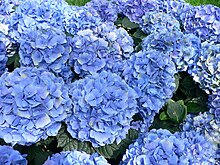Blue hydrangea (Rilke)
Blue hydrangea is the title of a sonnet by Rainer Maria Rilke . It can be found in the first part of the New Poems and is one of his most famous thing poems . Rilke does not describe the flower objectively, but concentrates on the interplay of its colors and uses metaphors and comparisons that are associated with certain emotions . As is typical for his middle creative period, the poems show the balance between the present object and its suspension in the subject .
content
The five-part iambic verses have the rhyme scheme abba bccb ded fef
and read:
Like the last green in color pots
, these leaves are dry, dull and rough,
behind the flower umbels, which
do not bear a blue on them, only reflect from a distance.
They reflect it tearfully and imprecisely,
as if they wanted to lose it again,
and like in old blue stationery there
is yellow in them, purple and gray;
Something faded like on a child's
apron , something no longer worn, to which nothing happens:
how do you feel the brevity of a small life.
But suddenly the blue seems to change itself
in one of the umbels, and one sees
a touching blue rejoicing with the green.
Background and interpretation
The Blue wins its own quality in these verses, acting as it were playing figure on the stage to the opponent Green concede only a minor role.
The colors, which became more and more important for Rilke (during his time in Paris with Auguste Rodin and the examination of the work of Paul Cézanne ), show an independent meaning in this poem compared to the objects: not the hydrangea, but the blue of its flowers and the green its leaves penetrate the consciousness and arouse feelings and memories .
If the “last green in color pots” makes the unsightly color of wilted leaves clearer, the “old blue stationery (s)” with the added colors show a certain characteristic of the faded blossom blue. By trying to grasp the perceived qualities of things as precisely as possible, Rilke simultaneously leads away from them and penetrates a range of emotions that express themselves surprisingly: “How do you feel the brevity of a small life”, an exclamation that is for the new Poetry is rare.
In the last trio, Rilke enlivens the blue, which can rejuvenate and “be happy”. The adjective “touching” like the verb “to be happy” are of an emotive nature and emphasize the emotional moments of the event.
Despite all the subjectivization, Rilke does not digress completely into the associative in the New Poems , but ultimately turns his gaze back to the object. The deictic pronouns in the counterpart pink hydrangea (“in these umbels”, “ the pink”) show how clearly he relates to something definable before him. The relation to things is not given up in the second part (the other part of the New Poems) , even if it is much weaker than in the first.
Wolfgang Müller contradicts the interpretation of Käte Hamburger , who believed to recognize Edmund Husserl's “process of phenomenological reduction” in the blue hydrangea and for which the blue is completely separated from the flower in order to remain in consciousness as an eidus . The sudden lighting at the end only exists as a contrast to the fading colors that are shown at the beginning and is still tied to the umbels.
Individual evidence
- ↑ Wolfgang G. Müller: Model analysis In: Rilke manual, life - work - effect. Metzler, Ed. Manfred Engel, Stuttgart 2013, p. 299
- ^ Rainer Maria Rilke, Blue Hydrangea, in: Complete Works, First Volume, Insel Verlag, Frankfurt am Main 1955, p. 519
- ^ So Rainer Gruenter, in Marcel Reich-Ranicki (Ed.): 1000 German poems and their interpretations. From Arno Holz to Rainer Maria Rilke. Insel-Verlag, Frankfurt am Main / Leipzig 1994, p. 288.
- ^ Rainer Maria Rilke, Rosa Hortensie, in: Complete Works, First Volume, Insel Verlag, Frankfurt am Main 1955, p. 633.
- ↑ Wolfgang G. Müller: Model analysis In: Rilke manual, life - work - effect. Metzler, Ed. Manfred Engel, Stuttgart 2013, p. 300.
- ↑ Wolfgang G. Müller, model analysis, in: Rilke manual, life - work - effect, Metzler, ed. Manfred Engel, Stuttgart 2013, p. 301.

